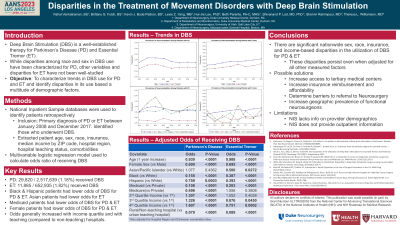Disparities in the Treatment of Movement Disorders with Deep Brain Stimulation
Friday, April 21, 2023


Vishal Venkatraman, BS (he/him/his)
Medical Student
Duke University
Durham, North Carolina, United States
ePoster Presenter(s)
Introduction: Deep Brain Stimulation (DBS) is a well-established therapy for Parkinson's Disease (PD) and Essential Tremor (ET), allowing for management after medical therapy has been ineffective. PD is more common in men and Hispanic patients, followed by white, Asian, and Black patients, and ET is more common in white patients, but there has been limited research on the differences in neurosurgical treatments for these conditions.
Methods: We queried the National Inpatient Sample database from January 1, 2012, to December 31, 2019, for all discharges with an ICD-9 or ICD-10 diagnosis of PD or ET. DBS rates were reported in each subgroup of race, ethnicity, and sex among these discharges. All analyses were weighted to generate national estimates.
Results: We identified 2,558,874 discharges with PD of which 30420 (1.2%) received DBS and 662,955 discharges with ET, of which 12085 (1.8%) received DBS. For PD, Black patients (n=410, 0.2%, OR=0.19, 95% CI 0.15-0.25) patients were less likely to receive DBS treatment than white (n=24,380, 1.2%) patients, whereas odds were not different between Hispanic (n=2050, 1.1%, OR=0.92, 95% CI 0.81-1.05) or Asian (n=860, 1.5%, OR=1.19, 95% CI 1.00-1.43) from white patients. For ET, Black (n=235, 0.8%, OR=0.43, 95% CI 0.3-0.61), Hispanic (n=230, 1.1%, OR=0.56, 95% CI 0.40-0.77), and Asian (n=55, 1.0%, OR=0.52, 95% CI 0.29-0.94) patients were less likely to receive DBS than white (n=10,605, 1.9%) patients. Female were less likely to receive DBS than male patients (PD: n=20,720, 1.4%, ET: n=6,540, 2.2%) for PD (n=9,695, 0.9%, OR=0.63, 95% CI 0.60-0.66) and ET (n=5,535, 1.5%, OR=0.69, 95% CI 0.64-0.75).
Conclusion : We discovered significant differences in DBS treatment of PD and ET based on race and gender. Further research should be conducted to determine the cause of these disparities, as well as any differences in access to specialty neurosurgical care and referrals for DBS.
Methods: We queried the National Inpatient Sample database from January 1, 2012, to December 31, 2019, for all discharges with an ICD-9 or ICD-10 diagnosis of PD or ET. DBS rates were reported in each subgroup of race, ethnicity, and sex among these discharges. All analyses were weighted to generate national estimates.
Results: We identified 2,558,874 discharges with PD of which 30420 (1.2%) received DBS and 662,955 discharges with ET, of which 12085 (1.8%) received DBS. For PD, Black patients (n=410, 0.2%, OR=0.19, 95% CI 0.15-0.25) patients were less likely to receive DBS treatment than white (n=24,380, 1.2%) patients, whereas odds were not different between Hispanic (n=2050, 1.1%, OR=0.92, 95% CI 0.81-1.05) or Asian (n=860, 1.5%, OR=1.19, 95% CI 1.00-1.43) from white patients. For ET, Black (n=235, 0.8%, OR=0.43, 95% CI 0.3-0.61), Hispanic (n=230, 1.1%, OR=0.56, 95% CI 0.40-0.77), and Asian (n=55, 1.0%, OR=0.52, 95% CI 0.29-0.94) patients were less likely to receive DBS than white (n=10,605, 1.9%) patients. Female were less likely to receive DBS than male patients (PD: n=20,720, 1.4%, ET: n=6,540, 2.2%) for PD (n=9,695, 0.9%, OR=0.63, 95% CI 0.60-0.66) and ET (n=5,535, 1.5%, OR=0.69, 95% CI 0.64-0.75).
Conclusion : We discovered significant differences in DBS treatment of PD and ET based on race and gender. Further research should be conducted to determine the cause of these disparities, as well as any differences in access to specialty neurosurgical care and referrals for DBS.
